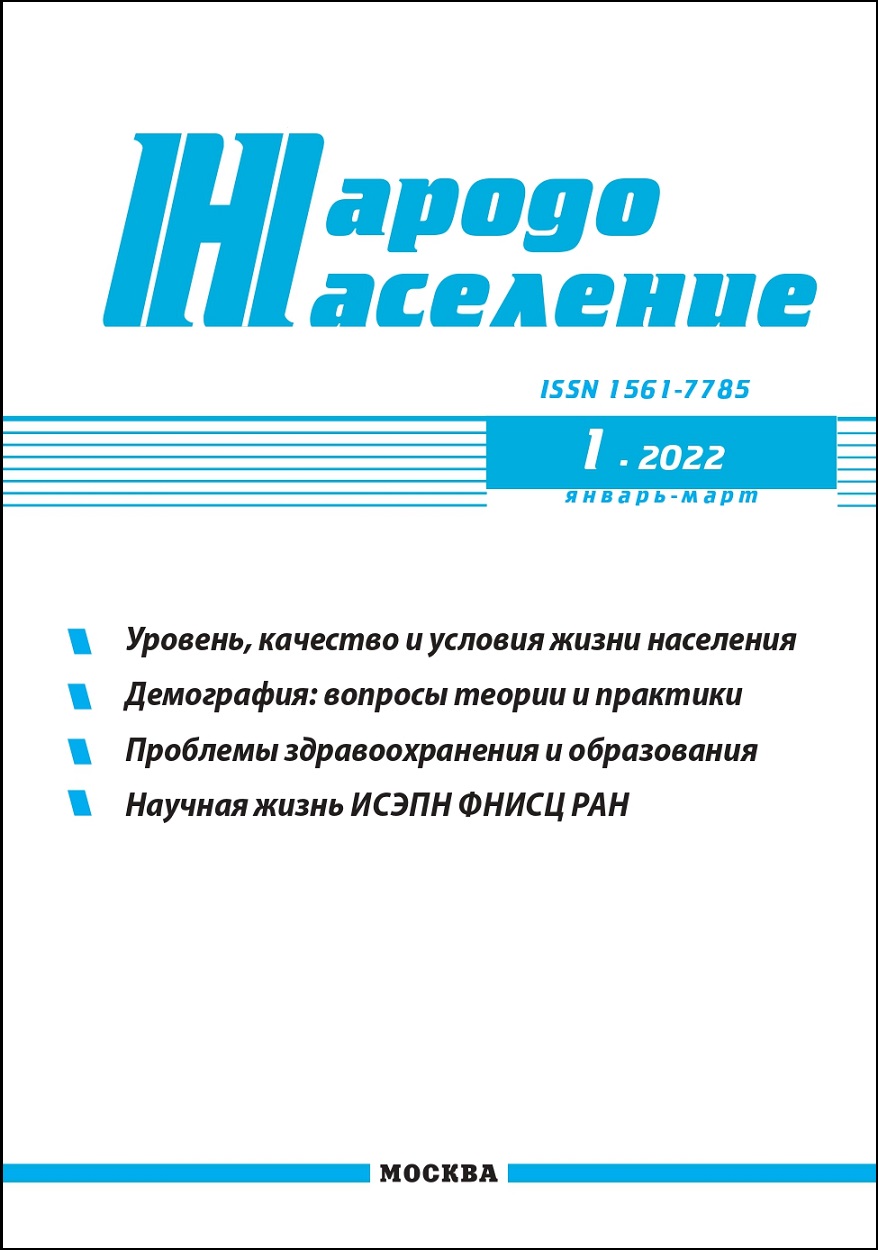Структурные волны населения России и её регионов: вопросы оценки и сравнения
Научная статья
Для цитирования
Рыбаковский О. Л. Структурные волны населения России и её регионов: вопросы оценки и сравнения // Народонаселение. 2022. Том 25. № 1. С. 65-79. DOI: https://doi.org/10.19181/population.2022.25.1.6
Аннотация
В статье рассматриваются методологические и методические вопросы сравнительного анализа возрастных структур населения, выявления уровня их неравномерности вследствие структурных демографических волн. Рассмотрены существующие в социально-экономическом анализе коэффициенты для измерения структурных различий рядов. Данные коэффициенты исследованы с позиции возможности их применения для измерения структурных демографических волн в России в целом и в её регионах. Эти коэффициенты необходимы не только для измерения и сравнения степени различий, неравномерности возрастных структур населения отдельных территорий, но и для мониторинга данной ситуации во времени. Последнее необходимо для выработки политики сглаживания структурных демографических волн. Предложенный в статье индекс (1-R), показывающий остаточную, не описанную коэффициентом детерминации величину ковариации, можно использовать на стадии предварительного анализа различий структур, так как он рассчитывается с помощью прикладных программ и даёт общую картину уровня неравномерности рядов, ранжирует их по этому признаку. По мнению автора, наиболее адекватный измеритель различий структур — это коэффициент неравномерности (Кп), рассчитываемый по аналогии с коэффициентом вариации. Он предпочтителен на основном этапе сравнительного анализа, так как выявляет среднюю относительную меру неравномерности пар рядов, прост и понятен в интерпретации. Три других подобных коэффициента (Гатева, Салаи, Рябцева) можно использовать в качестве дополнения для подтверждения адекватности сравнительного анализа, а также для общей оценки степени несоответствия рядов между собой с помощью привычной шкалы от нуля до единицы. Все 5 коэффициентов подходят не только для изучения возрастных структурных волн населения страны и её регионов, но и для сопоставления возрастных структур населения различных территорий между собой. Предложены рекомендации для сглаживания демографических структурных волн в России с помощью дифференцированной по времени и регионам демографической политики в области рождаемости и иммиграции.
Ключевые слова:
демографические структурные волны, возрастная структура населения России и её регионов, числа живущих в данном возрастном интервале, коэффициенты неравномерности структурных рядов
Литература
1. Рыбаковский, О.Л. Рождаемость населения России и демографические волны / О. Л. Рыбаковский, О. А. Таюнова // Народонаселение. — 2017. — № 4. — С. 56-66.
2. Рыбаковский, Л.Л. Особенности демографического развития России: прошлое, настоящее, будущее / Л. Л. Рыбаковский, В. И. Савинков, Н. И. Кожевникова // Социально-трудовые исследования. — 2021. — № 2. — С. 132-143.
3. Архангельский В.Н. Рождаемость в реальных поколениях российских женщин: тенденции и региональные различия / В. Н. Архангельский // Экономика. Налоги. Право. — 2019. — Т. 12. — № 2. — С. 59-69. DOI: 10.26794/1999-849X-2019-12-2-59-69.
4. Рыбаковский, Л.Л. Стратегия демографического развития России: её детерминанты и многовековой вектор / Л. Л. Рыбаковский, Н. И. Кожевникова // Уровень жизни населения регионов России. — 2020. — Т. 16. — № 4. — С. 9-20. DOI: 10.19181/lsprr.2020.16.4.1.
5. Пирожков С.И. Демографические процессы и возрастная структура населения С. И. Пирожков. — Москва: Статистика, 1976. — 136 с.
6. Зарова, Е.В. Региональная статистика / Е. В. Зарова, Т. В. Котенева, Т. И. Леонтьева [и др.]; ред. В. М. Рябцев, Г. И. Чудилин. — Москва: Московский издательский дом, 2001. — 380 с. ISBN 5-85167-035-5.
2. Рыбаковский, Л.Л. Особенности демографического развития России: прошлое, настоящее, будущее / Л. Л. Рыбаковский, В. И. Савинков, Н. И. Кожевникова // Социально-трудовые исследования. — 2021. — № 2. — С. 132-143.
3. Архангельский В.Н. Рождаемость в реальных поколениях российских женщин: тенденции и региональные различия / В. Н. Архангельский // Экономика. Налоги. Право. — 2019. — Т. 12. — № 2. — С. 59-69. DOI: 10.26794/1999-849X-2019-12-2-59-69.
4. Рыбаковский, Л.Л. Стратегия демографического развития России: её детерминанты и многовековой вектор / Л. Л. Рыбаковский, Н. И. Кожевникова // Уровень жизни населения регионов России. — 2020. — Т. 16. — № 4. — С. 9-20. DOI: 10.19181/lsprr.2020.16.4.1.
5. Пирожков С.И. Демографические процессы и возрастная структура населения С. И. Пирожков. — Москва: Статистика, 1976. — 136 с.
6. Зарова, Е.В. Региональная статистика / Е. В. Зарова, Т. В. Котенева, Т. И. Леонтьева [и др.]; ред. В. М. Рябцев, Г. И. Чудилин. — Москва: Московский издательский дом, 2001. — 380 с. ISBN 5-85167-035-5.
Статья
Поступила: 23.11.2021
Опубликована: 15.03.2022
Форматы цитирования
Другие форматы цитирования:
APA
Рыбаковский, О. Л. (2022). Структурные волны населения России и её регионов: вопросы оценки и сравнения. Народонаселение, 25(1), 65-79. https://doi.org/10.19181/population.2022.25.1.6
Раздел
ДЕМОГРАФИЯ: ВОПРОСЫ ТЕОРИИ И ПРАКТИКИ








